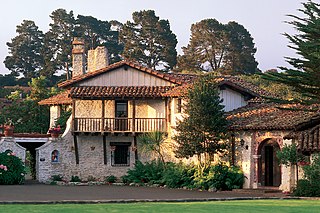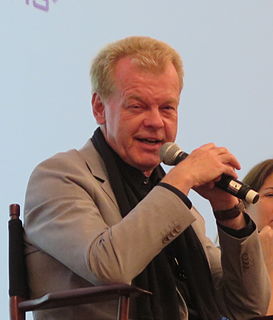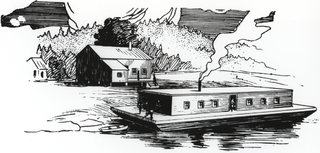See also
- Canary Row , a 1949 Merrie Melodies short
| This disambiguation page lists articles associated with the title Cannery Row. If an internal link led you here, you may wish to change the link to point directly to the intended article. |
Cannery Row is a street in Monterey, California.
Cannery Row may also refer to:
| This disambiguation page lists articles associated with the title Cannery Row. If an internal link led you here, you may wish to change the link to point directly to the intended article. |

John Ernst Steinbeck Jr. was an American author. He won the 1962 Nobel Prize in Literature "for his realistic and imaginative writings, combining as they do sympathetic humour and keen social perception." He has been called "a giant of American letters," and many of his works are considered classics of Western literature.

Monterey is a city located in Monterey County on the southern edge of Monterey Bay on California's Central Coast. Founded on June 3, 1770, it was the capital of Alta California under both Spain and Mexico. During this period, Monterey hosted California's first theater, public building, public library, publicly funded school, printing press, and newspaper. It was also originally the only port of entry for all taxable goods in California. In 1846 during the Mexican–American War, the United States flag was raised over the Customs House. After California was ceded to the U.S. after the war, Monterey hosted California's first constitutional convention in 1849.

Cannery Row is the waterfront street in the New Monterey section of Monterey, California. It is the site of a number of now-defunct sardine canning factories. The last cannery closed in 1973. The street name, formerly a nickname for Ocean View Avenue, became official in January 1958 to honor John Steinbeck and his well-known novel Cannery Row. In the novel's opening sentence, Steinbeck described the street as "a poem, a stink, a grating noise, a quality of light, a tone, a habit, a nostalgia, a dream."
Wetback is a derogatory term used in the United States to refer to foreign nationals residing in the U.S., most commonly Mexicans. The word mostly targets illegal immigrants in the United States. Generally used as an ethnic slur, the term was originally coined and applied only to Mexicans who entered the U.S. state of Texas from Mexico by crossing the Rio Grande river, which is the U.S. border, presumably by swimming or wading across the river and getting wet in the process.

Tortilla Flat is a 1942 American romantic comedy film directed by Victor Fleming and starring Spencer Tracy, Hedy Lamarr, John Garfield, Frank Morgan, Akim Tamiroff, and Sheldon Leonard based on the novel of the same name by John Steinbeck. Frank Morgan received an Academy Award nomination for Best Supporting Actor for his poignant portrayal of The Pirate.

Edward Flanders Robb Ricketts commonly known as Ed Ricketts, was an American marine biologist, ecologist, and philosopher. He is best known for Between Pacific Tides (1939), a pioneering study of intertidal ecology, and for his influence on writer John Steinbeck, which resulted in their collaboration on the Sea of Cortez, later republished as The Log from the Sea of Cortez (1951).
Bruce Wallace Ariss, Jr. was an American painter, muralist, writer, illustrator, editor as well as theater and set designer, amateur playwright and actor, and overall icon on the Monterey Peninsula, California.

Cannery Row is a 1982 American comedy-drama film directed by David S. Ward, starring Nick Nolte and Debra Winger. The movie is adapted from John Steinbeck's novels Cannery Row (1945) and Sweet Thursday (1954).

Sweet Thursday is a 1954 novel by John Steinbeck. It is a sequel to Cannery Row and set in the years after the end of World War II. According to the author, "Sweet Thursday" is the day between Lousy Wednesday and Waiting Friday.

Cannery Row is a novel by American author John Steinbeck, published in 1945. It is set during the Great Depression in Monterey, California, on a street lined with sardine canneries that is known as Cannery Row. The story revolves around the people living there: Lee Chong, the local grocer; Doc, a marine biologist; and Mack, the leader of a group of derelict people.

Pipe Dream is the seventh musical by the team of Richard Rodgers and Oscar Hammerstein II; it premiered on Broadway on November 30, 1955. The work is based on John Steinbeck's short novel Sweet Thursday—Steinbeck wrote the novel, a sequel to Cannery Row, in the hope of having it adapted into a musical. Set in Monterey, California, the musical tells the story of the romance between Doc, a marine biologist, and Suzy, who in the novel is a prostitute; her profession is only alluded to in the stage work. Pipe Dream was not an out right flop but was a financial disaster for Rodgers and Hammerstein.

David Schad Ward is an American film director and screenwriter. His screenplay for The Sting (1973) won him an Academy Award for Best Original Screenplay.

Cannery Rodent is a 1967 Tom and Jerry cartoon produced, written and directed by Chuck Jones. It was the final Tom and Jerry cartoon written and directed by Chuck Jones, and one of the last of the theatrical Tom and Jerry cartoons to be released by MGM.

Been Down So Long It Looks Like Up to Me is a novel by Richard Fariña. First published in the United States in 1966 the novel, based largely on Fariña's college experiences and travels, is a comic picaresque story that is set in the Western United States, in Cuba during the Cuban Revolution, and at an upstate New York university. The name of the protagonist is Gnossos Pappadopoulis, a modern Odysseus. The book has become something of a cult classic among those who study 1960s or counterculture literature, and has been cited as a source of inspiration for many artists including Earl Sweatshirt.

The Gulf of Georgia Cannery is a National Historic Site of Canada located in Steveston village in Richmond, British Columbia.

The Cannery Ballroom is a music venue in Nashville, Tennessee. It resides in Nashville's Historic Cannery building, located between the thriving The Gulch neighborhood and downtown. The building also houses two other music venues, the Mercy Lounge and The High Watt.

Pacific Biological Laboratories, abbreviated PBL, was a biological supply house that sold preserved animals and prepared specimen microscope slides, many of which were of maritime aquatic species, to schools, museums, and research institutions. It was located in a building on what is now Monterey's Cannery Row on Monterey Bay in Monterey County, California.

A salmon cannery is a factory that commercially cans salmon. It is a fish-processing industry that became established on the Pacific coast of North America during the 19th century, and subsequently expanded to other parts of the world that had easy access to salmon.

Canned fish are fish which have been processed, sealed in an airtight container such as a sealed tin can, and subjected to heat. Canning is a method of preserving food, and provides a typical shelf life ranging from one to five years.

The Hovden Cannery in Cannery Row, Monterey, California was among the oldest, largest canneries of the Pacific Sardine Fishery. In the first half of the 20th century, it marked one of the most lucrative national fisheries. It was a source for literary inspiration in the works of John Steinbeck.